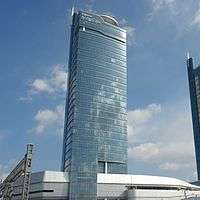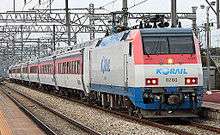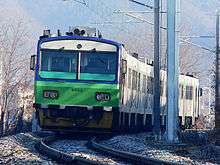Korail
 | |
 Headquarters of Korea Railroad Corporation | |
| Government-owned corporation | |
| Industry | Rail transport |
| Founded |
September 1, 1963 as Korean National Railroad January 1, 2005 renamed as Korail |
| Headquarters | Soje-dong, Dong-gu, Daejeon, South Korea |
|
| |
|
| |
| Website | info.korail.com letskorail.com |
| Korea Railroad | |
|---|---|
| Operation | |
| Infrastructure company | KR |
| Statistics | |
| Ridership | 969,145,101[2] |
| Passenger km | 31,415,965,207[2] |
| Freight | 10,553,675,728 ton km[2] |
| System length | |
| Total | 3,558.9 kilometres (2,211.4 mi) |
| Double track | 1,865.3 kilometres (1,159.0 mi) |
| Electrified | 2,356.7 kilometres (1,464.4 mi) |
| High-speed | 368.5 kilometres (229.0 mi) |
| Track gauge | |
| Main | 1,435 mm (4 ft 8 1⁄2 in) |
| High-speed | 1,435 mm (4 ft 8 1⁄2 in) |
| Electrification | |
| AC 25,000V 60Hz | 2,337.5 kilometres (1,452.5 mi) |
| DC 1,500V | 19.2 kilometres (11.9 mi) |
| Features | |
| No. stations | 652 |
| Highest elevation | 855 metres (2,805 ft) |
| at | 37°12′0″N 128°56′59.83″E / 37.20000°N 128.9499528°E |
| Korail | |
| Hangul | 한국철도공사 |
|---|---|
| Hanja | 韓國鐵道公社 |
| Revised Romanization | Hanguk cheoldo gongsa |
| McCune–Reischauer | Han’guk ch'ŏlto kongsa |
Korea Railroad Corporation (Korean: 한국철도공사, Hanjalang-k: 韓國鐵道公社), promoted as KORAIL (코레일), is the national railway operator in South Korea. Currently, KORAIL is a public corporation, managed by Ministry of Land, Infrastructure and Transportation.
KORAIL operates intercity/regional, commuter/metro and freight trains throughout South Korea, which has headquarter located in Daejeon.
History
Historically, South Korean railway network was managed by Railroad Administration Bureau of the Ministry of Transportation before 1963. On September 1, 1963, the bureau became an agency that was known as Korean National Railroad (KNR) in English. In early 2000's, split and public corporatization of KNR is decided by South Korean government, and in 2003, KNR adopted the current KORAIL logo in blue to prepare corporatization. On January 1, 2005, KNR was split into Korea Railroad Corporation (KORAIL), which succeeded railway operation with the KORAIL logo and name, and Korea Rail Network Authority (KR), which succeeded maintaining tracks.
Services
Excluding the other high-speed service provider, SR, South Korean high-speed and intercity services are provided by KORAIL. Currently, KORAIL provides 5 classes of railway and metro services.
KTX

KTX (Korea Train eXpress) is currently the highest class of KORAIL services. KTX services are provided in Gyeongbu HSR and Honam HSR, as well as their branches such as Gyeongjeon Line, Donghae Line, or Jeolla Line.
ITX

ITX (Intercity Train eXpress) are group of intercity services. First ITX service was introduced in 2012, which was named as ITX-Cheongchun (ITX-청춘) on Gyeongchun Line.
Before the introduction of ITX services, intercity trains are named as Saemaul-ho (새마을호), which borrowed its name from New Community Movement. Later, Saemaul-ho services are merged into ITX as ITX-Saemaul (ITX-새마을). Currently, remaining Saemaul-ho services are only operated on Janghang Line.
Mugunghwa-ho and Nuriro

Mugunghwa-ho (무궁화호) and its planned successor Nuriro (누리로) services are regional train services of KORAIL. Mugunghwa-ho, inspired its name from national floral emblem hibiscus, was introduced as express service at first, but after the introduction of KTX, it was degraded into regional services.
Currently, Nuriro services are provided by only EMU trains (class 20). KORAIL has a plan of introducing Nuriro with newly ordered EMU-150.
Commuter services

Commuter (Tonggeun) (통근열차) is commuter services operated with diesel multiple units (DMU). It was introduced in 2004, which was a successor of Tongil-ho (통일호). Currently, commuter trains are operated in Gyeongwon Line exclusively.
Metro services

Named as EMU services (전동열차), metro services are provided in Seoul Metropolitan area and Busan Metropolitan area. Sometimes it is considered as a successor of Bidulgi-ho (비둘기호). Officially, fare system of metro services are separated from the other services. Instead, it is merged into subway and bus fare system, providing fare discount of interchange.
- Seoul

- Gyeongbu Line — (Namyeong–Cheonan) is connected with Line 1
- Gyeongin Line (1900– ) — (Guro–Incheon) is connected with Line 1
- Gyeongwon Line — (Soyosan–Hoegi) is connected with Line 1
- Janghang Line — (Cheonan–Sinchang) is connected with Line 1

- Ilsan Line (1996– ) — partially underground; (Jichuk–Daehwa) is connected with Line 3

- Ansan Line (1988– ) — (Geumjeong–Oido) is connected with Line 4
- Gwacheon Line (1994– ) — underground; (Seonbawi–Geumjeong) is connected with Line 4
- Bundang Bundang Line (1994– ) — underground; (Wangsimni–Suwon)
- Suin Suin Line (2012– ) — partly underground; (Suwon–Incheon)
- Gyeongchun Gyeongchun Line — (Seoul–Chuncheon)
- Gyeongui–Jungang Gyeongui–Jungang Line
- Gyeongui Line — (Seoul–Munsan) is part of Gyeongui–Jungang Line service
- Gyeongwon Line — (Hoegi–Yongsan) is part of Gyeongeui–Jungang Line service
- Jungang Line — (Cheongnyangni–Jipyeong) is part of Gyeongeui–Jungang Line service
- Yongsan Line — underground; (Yongsan–Gajwa) is part of Gyeongui–Jungang Line service
- Gyeonggang Gyeonggang Line (2016– ) — partially underground; (Pangyo–Yeoju)
- Busan

Sightseeing trains
KORAIL has a number of tourist or sightseeing trains, including the Sea Train, DMZ Train, O-Train, V-Train, S-Train, A-Train, and G-Train.[3]
Passes
Korail offers a rail pass called Korea Rail Pass, or KR Pass for short, to foreign travelers, such that they can take most of the trains operated by Korail freely, including KTX. But subways and tourist trains by KORAIL are not covered.[4]
Foreigners living in South Korea for more than six months are ineligible for using KR Pass, but Korail offers the Happy Rail Pass, which is very similar to the KR Pass, for a slightly a higher price.[4]
Labour relations
Most of the railroad's employees are members of the Korean Railway Workers' Union, which is frequently at odds with KORAIL management. Strikes, such as the South Korean railroad strike of 2006, are not uncommon.
In December 2013, 23,000–100,000 union members and friends protested the privatization of KORAIL in Seoul.[5]
Subsidiaries
- Airport Railroad Corporation, which operates A'REX.
- Korail Networks, for ticketing management and Korail frequent riders program.
- Korail Retail, for advertisement management and running "Storyway" convenience store.
- Korail Tour Service, for KTX/Saemaul-ho train crew and travel service.
International service
Until the division of Korea following the end of the Second World War, the Gyeongui Line and Gyeongwon Line extended into what is now North Korea. The Gyeongui Line connected Seoul to Kaesong, Pyongyang, and Sinuiju on the Chinese border, while the Gyeongwon Line served Wonsan on the east coast. Another line—the Kumgangsan Electric Railway—connected the town of Cheorwon, now on the border of North and South Korea, on the Gyeongwon Line, to Mt. Geumgang, now in the North.
The Gyeongui Line is one of two lines whose southern and northern halves are now being reconnected, the other line being the Donghae Bukbu Line. On 17 May 2007, two test trains ran on the reconnected lines: one on the west line from Munsan to Kaesong; the second on the east from Jejin to Kumgang.[6]
In December 2007, regular freight service started on the Gyeongui line, from South Korea into the Kaesong Industrial Park in the north. The service has been underutilized, however: as it was reported in October 2008, on 150 out of 163 return trips that had been done so far, the train carried no cargo at all. The total amount of cargo carried over this period had been merely 340 tons. This absence of interest in the service has been explained by the customers' (companies operating in Kaesong) preference for road transport.[7] In November 2008, North Korea shut down the link.
A Trans-Korean Main Line, spanning North Korea and connecting to Russian Railways, is planned.[8]
Japan Rail Kyushu offers a jet foil ferry service between Busan and Fukuoka taking about 3 hours. KORAIL and Japan Rail West had a joint rail pass (called 한일공동승차권) which includes discounted KTX and Shinkansen ticket with Busan-Shimonoseki/Fukuoka ferry ticket, but the pass was out due to low ridership.
There is no railway connection between both country. Korean strait undersea tunnel was proposed from Fukuoka to Busan via Tsushima as far back as 1917, but the plan has never progressed past the research phase. While the increased wealth of South Korea and continued growth of trade between the nations has made the economic case for the tunnel more compelling, promotion has focused more on using the project to reduce political tension between the nations.[9]
See also
- List of Korea-related topics
- List of suburban and commuter rail systems
- Korean State Railway, North Korea's national rail operator
- Incheon Korail FC, Korea National League football team.
- Korea Rail Network Authority
- KTX Family Card, frequent riders program
- Transportation in South Korea
References
- 1 2 "2010 Statements of Income". Korail. Archived from the original on 2013-06-29. Retrieved 2013-05-28.
- 1 2 3 "KOSIS 국가통계포털".
- ↑ Lee, Sun-Min (January 24, 2015). "Planned G-Train offers tourists ultimate comfort". JoongAng Ilbo. Retrieved February 27, 2015.
- 1 2 "Official Site of Korea Tourism Org.: Railroad Passes".
- ↑ "[現場] 寒波の中 10万の人波 「国民を敵に回すな」".
- ↑ "Korean trains in historic link-up". BBC News. 2007-05-17. Retrieved 2007-05-17.
- ↑ Richard Spencer (23 Oct 2008). "Korean detente railway becomes ghost train". The Daily Telegraph. London.
- ↑ "Trans-Korean Main Line - Investment in the Future - Russian Transport Daily Report". 2010-10-29. Archived from the original on 2011-02-27. Retrieved 2010-10-30.
- ↑ Cazzaniga, Pino (October 13, 2009). "Japan and South Korea Increasingly Closer: The Two Nations Are Now Planning The Future Together: An Underwater Tunnel, A Common History Book..." Japan: AsiaNews.it. Retrieved December 4, 2009.
External links
| Wikimedia Commons has media related to Korea Railroad. |